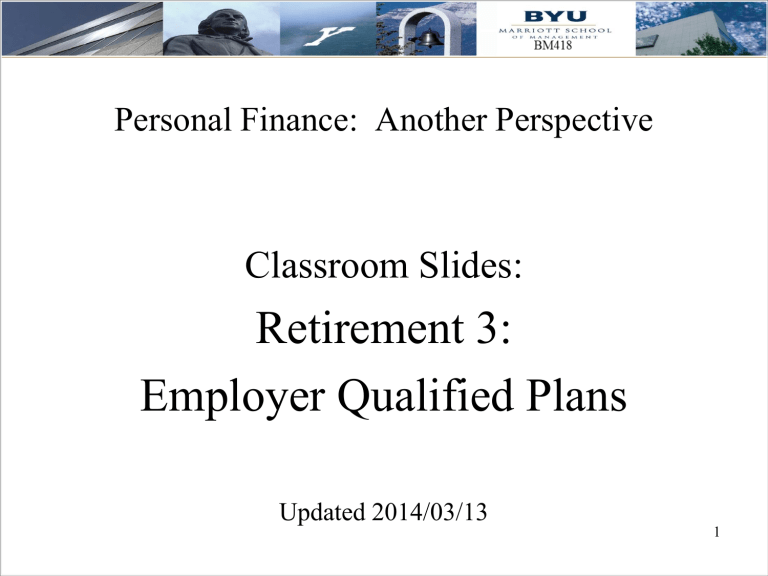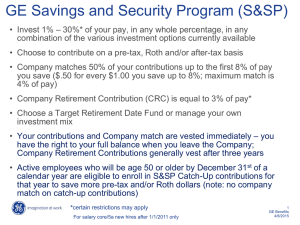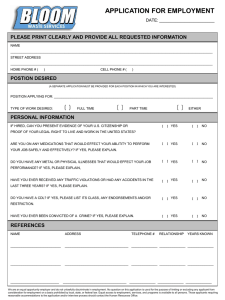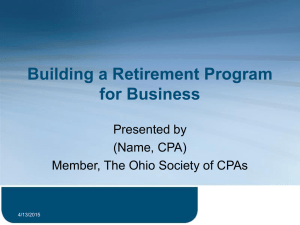here - Personal Finance

Personal Finance: Another Perspective
Classroom Slides:
Retirement 3:
Employer Qualified Plans
Updated 2014/03/13
1
Objectives
A. Understand Employer Qualified Retirement
Plans
B. Understand Defined Benefit Plans
C. Understand Defined Contribution Plans
2
A. Understand Employer Qualified
Retirement Plans
• Why do companies set up retirement plans?
• Competition
• Tax shelters
• Personal retirement for the owners
• Personal retirement for the employees
• Other reasons
• What are the requirements for setting up retirement plans?
• Generally stable and available cash flow
• Willingness to fulfill financial reporting
3
Employer Qualified Plans
(continued)
Two Kinds of
Employer Qualified Plans (EQPs)
Employer Funded
Pension Plans
Employer Sponsored
Retirement Plans
(Defined Benefit Plans) (Defined Contribution Plans)
4
4
Employer Qualified Plans
(continued)
Defined Defined
Characteristics: Benefit Contribution
Employers Actuarially Specified by contribution: determined formula
Benefit amount: Certain Uncertain
IRC* limits apply: Maximum benefits funded
Contributions
Types of Plans: Defined Profit Sharing
Benefit Pension ESOP
Cash Balance Stock Bonus
Pension Target Benefit
Money Purchase
IRC = Internal Revenue Code Employee Contribution
5
Employer Qualified Plans: Business Forms
6 6
Employer Qualified Plans
(continued)
• Funding limits are set in IRS Code 415 which limit the maximum individual funded benefit in
2014
Defined Defined
IRS Limits : Benefit Contribution
Participant 100% or 100% or
$210,000 $52,000
(indexed) (indexed) if less if less
Employer Amount 25% of all
Necessary to Participants
Fund Compensation Compensation
7
Employer Qualified Plans
(continued
Year
2009
2010
2011
US$ Changes to IRS Code 415 Limits for Qualified Retirement Plans
Defined Defined
Benefit Contribution
195,000 49,000
195,000 49,000
195,000 49,000
2012
2013
2014
200,000 50,000
205,000 51,000
210,000 52,000 8
Employer Qualified Plans
(continued)
• There has been a shift in EQPs
• With defined benefit plans, the risk of funding a specific amount each year is with the company
• With defined contribution plans, the risk of funding a specific amount each year is with the employee
• We are seeing fewer defined benefit plans as well as a reduction in the benefits from these plans
• Defined benefit plans have dropped from 175,000 plans in 1983 to less than 20,000 today
• Risk has been essentially shifted from the company to the employee
9
Employer Qualified Plans
(continued)
• Key benefits to EQPs
• Employer contributions are tax-deductible to the employer and are not taxable to the employee in the year given
• Earnings are tax deferred to the participant until retirement
10
Questions
• Do you understand Qualified Retirement
Plans?
11
B. Understand Defined Benefit Plans
• What is a defined benefit plan (DBP)?
•
A retirement plan funded entirely by the employer in which the payout amount is guaranteed. Benefits are based on: a benefit formula, the definition of compensation, and full retirement age
• What are the characteristics of a DBP?
• Employees do not contribute and bear no risk
• Employees receive a “promise” of a defined payout at retirement, which is based on a benefit formula
• What are the main types of DBP?
• Defined Benefit Pension Plan
• Cash Balance Plan
12
Defined Benefit Pension Plans
•
A Defined Benefit Pension Plan is a DBP where payments are based on a benefit payout formula
•
This formula is based on your salary, years worked and a company determined factor to calculate how much you will get each year
•
Example for XYZ corporation:
•
Calculate average of five highest annual salaries within the last ten years
• Multiply final “average” salary by a company determined factor of 1.5%, and
•
Multiple this by years in service (to a max of 33)
•
For XYZ Corporation: $60,000 x .015 x 25 yrs = $22,500 or 37.5% of final salary
13
Defined Benefit Pension Plans
(continued)
• Advantages
•
Employees do not contribute and bear no risk
•
Benefits may be extended to spouse
• Some plans provide 30% to 70% of final salary
• Disadvantages
•
Benefits are considered taxable income
•
Firms can change policies even after you retire
• Lack of portability and vesting is required
• Most do not provide for inflation (no COLA)
• Some plans are unfunded, meaning payments are made out of current company earnings
14
Cash-Balance Plans
• What are Cash-Balance plans?
•
A type of DBP in which provides specific annual employer contribution (generally 4-7%) each year, plus a low but guaranteed rate of investment earnings
• How is this different from a DCP?
•
Accounts grow at a predetermined rate, regardless of how much is in the account
• Employees do not make any investment decisions
15
Cash-Balance Plans
(continued)
• Advantages
•
Employees do not contribute, benefits are easier to track, and maximum benefit is the lesser of 100% of compensation or $210,000 in 2014
•
The investment rate of return is low but constant
•
Plans are portable, and cheaper for the company
•
Plans may be used to eliminate a traditional defined benefit plan by an employer
•
Disadvantages
• Actual payouts may be less than the basic defined benefit plans
• Costly for employers to maintain this type of plan 16
Defined Benefit Plan: Distribution/Payout Options
(Example: BYU Defined Benefit Plan)
• Distribution relates to how long you will receive benefits, whether and how much your spouse receives after you die, and the guaranteed period for which you will receive benefits. There are 4 main distribution options:
1. Life Annuities (guaranteed for the “certain” period)
• Life annuity
•
10 year Certain & Life, 15 year Certain & Life, 20 year Certain & Life
2. Joint and Survivor Annuities (percent relates to the amount the spouse receives
• Joint & Survivor 100 percent Annuity (10 year certain)
•
•
Joint & Survivor 75 percent Annuity (10 year certain)
17
Joint & Survivor 50 percent Annuity (10 year certain)
Distribution/Payout Options
3. Special Joint and Survivor Annuity (if there is a death in the marriage the benefit decreases)
•
Special Joint & Survivor two-thirds annuity (10 year certain)
4. Qualified Joint & Survivor Annuity (same as the 50% option with no term certain)
•
Qualified Joint & Survivor Annuity (50% and no term certain)
•
Note that if you choose options that have certain payments for longer periods of time, the amount received each month will be less.
• If an employee dies prior to retirement, generally the surviving spouse is restricted to QJSA option.
18
Important Questions to ask when Considering
Defined Benefit Plans
• What questions should you ask?
•
What salary is your pension based: average compensation, final year’s salary, or some other amount?
•
What is the vesting period?
•
What is the formula for calculating benefits?
• What’s the normal retirement age? What happens to your pension amount if you retire sooner?
•
Is there any advantage to working past age 65?
•
Is there a cost of living adjustment (COLA) for inflation?
19
Questions
• Do you understand Defined Benefit Plans?
20
C. Understand Defined Contribution Plans
• What is a Defined Contribution Plan (DCP)?
•
A retirement plan where the employer contributes a specific amount to the employee’s retirement funds while the employee is working and then has no responsibilities once the employee retires
• What are the characteristics of a DCP?
•
Employer contributes to a fund, and then has no additional obligation when the employee retires
• Employee may also contribute to the fund
•
Pension is determined by how much is invested by both the employer and employee, and how fast it grows
21
Defined Contribution Plans
(continued)
•
Defined Contribution plans may be three types:
• 1. Discretionary contribution plans
•
Contributions are at employer discretion
• Profit Sharing Plan
•
Stock Bonus or ESOP Plan
• Money Purchase plan
•
2. Fixed contribution plans
•
Contributions are fixed by the employer.
Examples are:
•
Thrift and Savings plans
• Target benefit plan
•
3. Employee contribution plans (salary reduction)
22
Defined Contribution Plans
(continued)
• Different types of defined contribution plans?
• 1. Discretionary Contribution Plans
• Profit Sharing Plans
• Plan where employer contributions vary yearto-year depending on firm profitability (it may be zero if the firm is not profitable in that year)
• Stock Bonus Plan
• Plan where employer contributions are made with employer shares of stock. Employee stock ownership plans (ESOPs) and leveraged ESOPs
(LESOPs) are the most common
23
Defined Contribution Plans
(continued)
• Money Purchase Plans
• Plan where employer contributes a percentage of employee salary each year, not dependent on company profits
• Employees do not contribute
24
Defined Contribution Plans
(continued)
2. Fixed Contribution Plans
• Thrift /Savings Plans (TSP)
• Plan where employer matches a percentage of employee contributions to a specific amount
(i.e., free money). This program is for employees of federal civil service
• Target Benefit Plan
• Defined contribution plans that establish a required contribution level to meet a specific target level of benefits at retirement
25
Defined Contribution Plans
(continued)
• 3. Employee Contribution or Salary Reduction
Plans
• Employees contribute before tax dollars reducing their taxable income
• Earnings accumulate tax deferred
•
55 million employees participate in 401(k) plans
•
89% of 401(k) plans have matching contributions
26
Defined Contribution Plans
(continued)
• Types of Employee or Salary Reduction Plans
• 401k Plans or Roth 401k Plans
• Plan where employees contribute a percent of salary up to a specified amount ($17,500 in
2014. Employers may contribute a matching amount (free money) to encourage participation
• 403b Plans or Roth 403(b) Plans (also called Tax
Sheltered Annuities)
• Same as 401k but for non-profit tax-exempt companies and institutions (i.e., schools)
• 457 Plans
• Same as 401k but for state and municipal workers and tax-exempt organizations
27
Defined Contribution Plans
(continued)
• What are the differences between Roth
401k/403b Plans and traditional salary reduction plans?
• Roth Plans are after tax, with no tax deferral
• Distributions of contributions can be made without penalty and without tax after 5 years
• Roth plans do not have mandatory distributions (if they are rolled over into Roth IRAs at retirement)
• Matching employer contributions with Roth plans go into traditional plans (not Roth plans)
• Roth plans allow you to save more money (as taxes are paid outside the retirement vehicle) 28
Defined Contribution Plans
(continued)
• Salary Reduction Plans
• Employees direct the funds into different financial asset options including:
• Mutual funds, index funds, fixed income, equities, money market funds, and GICs
(guaranteed investment contracts)
• Companies have their list of approved investment assets
• Employees choose where to invest their assets subject to the company list
• Employees are not allowed to invest outside of approved investment assets
29
Defined Contribution Plans
(continued)
• Advantages to Employees
•
May offer strong growth potential
•
Greater sense of control and portability
• Tax advantages from tax deferred contribution and earnings, or tax-elimination with Roth Plans
•
Disadvantages to employees
•
No guarantee of actual amounts available at retirement
•
Risk is shifted from the employer to the employee
30
Defined Contribution Plans
(continued)
• Advantages to Employers
•
Easier to administer
•
Less government regulation
• Greater employee investment choice
• Shifts investment decisions to employee
• Many varieties
•
Disadvantages
• Takes time and resources to administer
31
Type
Defined Contribution Plans
(continued)
Funding Contribution Eligibility
Loan
Privilege
Money Purchase
Plans
Employer
Employer contributes to plan based on a formula that covers all participating employees
All eligible compnay employees
NO
Profit Sharing
Plans
Employer
Employer contributes percentage of profits;
All eligible compnay some plans are based on total profits; employees while others use a sliding scale
YES
Employee Stock
Ownership Plans
Employer
Employer contributes stock or subsidizes employee purchase as stock
Employees of stock-issuing businesses
Thrift or Savings
Plans
Employer and
Employee
401 (k) Plans
403 (b) Plans
Employer and
Employee
Employer and
Employee
Employer matches some or all of the amount an employee defers from pre-tax salary into the plan
Federal employees and emplyees of companies offering plans
Employee contributes pre-tax salary to the plan; employer may, and often does, All employees of businesses contribute an amount based on an announced formula that sponsor plans
Emplyee contributes pre-tax salary to the plan; employer may and often does, contribute an additional amount
Restricted to employees of non-profit, tax-exempt employers
Section 457
Plans
Employee
Employee contributes pre-tax salary to the Restricted to state and plan municipal workers.
Source: Wall Street Journal Guide to Planning Your Financial Future
NO
YES
YES
YES
YES
32
Defined Contribution Plans
(continued)
Thoughts on Defined Benefit/Contribution
Plans
• 75% of plan balances are invested in equities
• Mutual funds still provide bulk of investment opportunities, although some firms are forming brokerage links for stocks
• Most plans typically provide 10+ options
Important questions to ask:
•
What are annual or administration expenses?
•
Are there any transfer fees to go from one fund to another?
•
How often can I reallocate my assets? Costs?
33
Defined Contribution Plans
(continued)
• US$ Annual Contribution Limits for a 401(k),
Roth 401(k), 403(b), Roth 403(b), and 457
Plan:**
Year Contribution Limit Catch Up Contr.*
2010
2011
2012
16,500
16,500
17,000
5,500
5,500
5,500
2013 17,500 5,500
2014 17,500 5,500
•
* Catch up contribution is for those over age 50
• ** 457 Plan participants also have the option of the final 3 years before retirement to increase their deferrals to the lesser of twice the normal limit ($35,000 in 2014) or the normal limit not applied in previous years.
34
Defined Contribution Plans
(continued)
• What is vesting?
•
Vesting is the process whereby funds contributed by the employer actually become the property of the employee.
•
What is the vesting schedule of most plans?
•
100% of employee contributions/deferrals are vested immediately
•
Generally vesting schedules apply only to employer contributions, i.e., 60% after 2 years, 80% after 3 years, and 100% after 4 years
35
Defined Contribution Plans
(continued)
• Matching contribution must vest according to the respective cliff or graded schedules:
401k Vesting 403b Vesting
Year Cliff Graded Cliff Graded
1. 0% 0% 0 0
2. 0 20 0 0
3. 100 40 0 20
4. 100 60 0 40
5. 100 80 100 60
6. 100 100 100 80
7. 100% 100% 100% 100%
36
Tax Considerations
• What are the tax considerations of DCPs?
•
All retirement income, including capital gains, are taxed as ordinary income when distributed
•
10% penalty rule applies for early withdrawals before 59½ , with some exceptions
•
There is a 20% withholding requirement
•
Certain loan provisions may apply
•
Mandatory annual distributions begins after age
70½
37
Defined Contribution Plans
(continued)
•
Required minimum distributions must begin by April
1 st of the year following age 70½.
• The distribution is the account balance on Dec. 31 of the previous year (age 69) divided by the life expectancy from the table below. There is a 50% penalty on minimum distributions not taken.
Uniform Table
Age Life Expectancy (LE) Age LE
70
71
72
73
27.4
26.5
25.6
24.7
74 23.8
75
76
77
78
79
22.9
22.0
21.2
20.3
19.5
38
Payout/Distribution Options?
•
What are my four payout or distribution options for defined contribution plans?
•
Payout/distribution options are ways the employee can receive your money at retirement
•
1. Lump Sum Distribution or as Needed
•
Benefits
• Take the money out as you need it
•
Can invest/gift/use it elsewhere
• Risks
•
Plans only allow distributions every 3 months
• Taxes are incurred immediately
•
If not plan well, may not have sufficient money for retirement
39
Payout/Distribution Options
(continued)
• 2. Purchase of an Immediate Annuity
•
Use DCP to purchase an immediate annuity (You can purchase this contract either from your retirement Plan provider or from others outside the
Plan)
• Benefits
•
Stable payments usually for life
•
Useful for planning and tax purposes
•
Risks
• Generally no cost of living adjustment
• Tax is due on amount received each year
40
Payout/Distribution Options
(continued)
• 3. Take Periodic Payments
•
Benefits
•
Can plan for regular payments at regular intervals. Can ensure that payments are available for a specific period of time
•
Payments may be large
•
Risks
•
No assurance of lifetime income
• Tax rate may be high due to the amount of money withdrawn
41
Payout/Distribution Options
(continued)
• 4. Roll it into an IRA Rollover (Be careful and don’t touch the funds)
•
Benefits
•
You can defer taxes until you withdraw the funds
•
You can direct investment to different assets and asset classes
•
You can continue to enjoy tax-deferred growth
•
Risks
• There is no guarantee that funds will last a lifetime
• You must begin withdrawals at 70½ or 50% penalty is incurred 42
Important Questions to ask when Considering
Defined Contribution Plans
• Questions for Defined Contribution Plans?
•
Do you have a match?
•
How much is it?
• How soon until I can contribute to get the match?
• What is the vesting period for the match?
• What is the normal retirement age?
•
Is there any advantage to working past age 65?
43
Questions
• Do you understand Defined Contribution
Plans?
44
Review of Objectives
A. Do you understand Employer Qualified
Retirement Plans?
B. Do you understand Defined Benefit Plans?
C. Do you understand Defined Contribution
Plans?
45
Case Study #1
Data
• Bill, married with two kids, will be graduating in April with his bachelors degree, and has two similar offers from companies both located in San Francisco,
California. Both companies are companies he would be content to stay with for 30 years. Company A has a
401k with a 100% match up to 4% of his salary.
Company B has a 401k with no match, but a Defined
Benefit Plan with the formula based on average salary, a factor of 1.5%, and years of service up to 30 years.
Calculations/Application:
• A. Assuming the salary is $50,000 for either firm, which has the more attractive retirement package for Bill?
• B. Can Bill participate in other retirement plans?
46
Both companies are companies he would be content to stay with for 30 years. Company A has a 401k with a 100% match up to 4% of his salary. Company B has a 401k with no match, but a Defined Benefit Plan with the formula based on average salary, a factor of 1.5%, and years of service up to 30 years. A. Assuming the salary is $50,000 for either firm, which has the more attractive retirement package for Bill? B. Can Bill participate in other retirement plans?
47 47
Case Study #1 Answer
Calculations/Applications:
• A. This is a difficult question to answer, and which depends on : 1. Bill, 2. Bill’s forecast for the company, and 3. Bill’s view of company policy.
• 1. Bill. How long is he planning to be with either company? Is he going back to graduate school soon?
How portable is the defined benefit plan? The answer to this question is really based on the assumptions that
Bill has regarding how long he plans to stay with either company. Since a defined benefit plan generally requires you to stay for an extended period, that benefit will only be valuable if Bill is committed for a long period of time.
48
Case Study #1 Answer
• 2. Bill’s forecast for the company. Is the company viable, particularly company B? Will company B be around for as long as Bill wants them to? Are the products of both companies viable?
• 3. Bill’s view of company policy. Will either company change its retirement policies after Bill retires? Have the companies historically taken good care of their employees? Are the plans consistent with similar companies? What is Company B’s defined benefit formula? If Bill stays until retirement at B, what is the annual benefit? Assuming a reasonable interest rate, what is the present value of the annual benefit to Bill? What is the value of the company match over the same period?
49
Case Study #1 Answer
• B. Bill can have other plans, as long as his salary is below specific IRS determined limits.
Based on the information provided, he could also invest in either a Roth or traditional IRA, or if he had a small business, he may be able to invest in a small business plan such as a SEP-
IRA.
50
Case Study #2
Data:
• Greg is 50 years old and has been working for 10 years with a company that has a defined benefit plan. The formula is the five highest annual salary years within the last ten years multiplied by a company determined factor of 1.5%, times years in service (to a maximum of 33). Assuming Greg stays with the company until his retirement at age 65, an assuming his highest five years annual salaries average $60,000.
Calculations:
• A. How much can Greg expect to receive annually at retirement?
• B. What is the percent of his final 5 year average salary?
51
Greg is 50 years old and has been working for 10 years with a company that has a defined benefit plan. The formula is the five highest annual salaries within the last ten years multiplied by a company determined factor of 1.5%, times years in service (to a maximum of 33). Assuming
Greg stays with the company until his retirement at age 65, an assuming his highest five years annual salaries average $60,000. A. How much can
Greg expect to receive annually at retirement? B. What is the percent of his final 5 year average salary?
52 52
Case Study #2 Answer
• A. Greg can expect to receive:
• $60,000 x .015 x 25 yrs = $22,500
• B. This is $22,500/$60,000 or 37.5% of his final salary
53
Case Study #3
Data:
• Bill is 55 and plans to retire in 10 years. He is working for a company with a Tax Sheltered Annuity (TSA or
403b Plan).
Calculations
• A. How much can he contribute into his company’s Roth 403b plan in 2014?
• B. If is company has a matching program, what impact will that have on Bill’s contribution?
54
Bill is 55 and plans to retire in 10 years. He is working for a company with a Tax Sheltered Annuity (TSA or 403b Plan). A.
How much can he contribute, assuming his salary is below the IRS determined limits, into his company’s Roth 403b plan in
2014? B. If is company has a matching program, what impact will that have on Bill’s contribution?
55 55
Case Study #3 Answer
• A. Contribution limits for the 401(k), Roth 401(k),
403(b), Roth 403(b), and 457 Plan annual contribution limits are:
Year
2012
Contribution Limit Catch Up Contr.
17,000 5,500
2013
2014
17,500
17,500
5,500
5,500
Since Bill is over 50 years old, he could contribute
$17,500 plus a $5,500 catch up contribution in
2014 for a total of $23,000
B. The company match will have no impact on the amount that Bill can contribute 56
Case Study #4
Data:
• Bill retired on his 60 th birthday and did not use any of his traditional IRA balances. On December 31 st of his
69 th year, he had $450,000 in his 401k plan.
Calculations:
• A. How much would he be required to take out of his account the next year, i.e. the year he turns 70
1/2? (use the table below)
• B. How much would he be required to take out if this was a Roth 401k?
Age Life Expectancy (LE) Age LE
70
72
27.4
25.6
71
73
26.5
24.7
57
Bill retired on his 60 th birthday and did not use any of his traditional IRA balances. On December 31 st of his 69 th year, he had $250,000 in his 401k plan. A. How much would he be required to take out of his account the next year, i.e. the year he turns 70 1/2? B. How much would he be required to take out if this was a Roth 401k?
58 58
Case Study #4 Answers
• A. From the table, his life expectance is at age 70 is
27.4. Bill will be required to take a distribution of his
401k plan of $450,000 / 27.4 or:
• $16,423 the next year.
• B. If this was a Roth 401k, he would still have to take the required distributions. However, if once he retired, he rolled his Roth 401k over to a Roth IRA, there would be no required distributions
• The tax rules have yet to catch up with the retirement vehicles
59
Case Study #5
Data:
• You just got out of school last year and you have already begun your retirement program. You have invested enough in your company 401k plan to get your company match this year, and have found out that your company has a Roth 401k plan as an option. You are discussing with a friend the benefits of the Roth 401k versus the Traditional 401k.
Application: a. Which vehicle, the Roth or traditional 401k should you select and why? b. What are your assumptions that would impact your choice of retirement vehicle?
60
Case Study #5 Answers a. Which vehicle you choose should be based on your goals, objectives, and assumptions for the future b. Your assumptions should relate to five key areas:
1. What is your projected tax rate in retirement?
If you expect your tax rate to be higher (lower) in retirement, the Roth (traditional) is preferred.
Make sure you take into account your child tax and other credits when determining your current tax rate.
2. Do you need for the tax break now?
If the reduction in AGI is important for you to reduce your current tax bill, then you would likely choose the traditional
61
Case Study #5 Answers
3. Do you have the cash to pay your taxes now?
If you have additional money to invest for retirement, you can invest more in the Roth than the traditional. That is because you pay your taxes on the Roth money outside of your retirement account. You can actual put in more money into the Roth IRA due to taxes.
4. Do you have a possible need for principle?
If you may need money in the account (just in case), with the Roth you can take out principle after 5 years without penalty or taxes, as principle has already been taxed. You cannot, however, take out earnings and interest without penalty.
62
Case Study #5 Answers
• 5. Do you desire to have more money saved at retirement?
If you want to put more money in for retirement, since you pay taxes outside the retirement vehicle with a
Roth vehicle, you are actually saving more for retirement.
For example, if you put both $5,000 into both a Roth and traditional IRA, the Roth will be worth more at retirement as you must pay taxes on the traditional
IRA when you pull out the money at retirement
63






